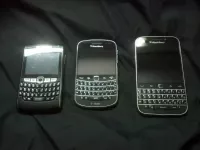The iPhone is a line of smartphones developed and marketed by Apple, utilizing the iOS operating system. The original iPhone was announced by Steve Jobs in 2007. Apple has released new iPhone models and iOS versions annually since then. The most recent models are the iPhone 16 and 16 Plus, alongside the higher-end iPhone 16 Pro and 16 Pro Max, and the lower-end iPhone 16e. As of January 1, 2024, over 2.3 billion iPhones have been sold, establishing Apple as the leading mobile phone vendor in 2023.
January 9, 2007: iPhone Announcement at Macworld 2007
On January 9, 2007, Steve Jobs announced the first-generation iPhone at Macworld 2007. This marked the introduction of Apple's smartphone line and its iOS operating system.
June 11, 2007: iPhone to Support Third-Party Ajax Web Applications
On June 11, 2007, at WWDC 2007, Apple announced that the iPhone would support third-party Ajax web applications with an iPhone-like interface.
June 29, 2007: First-Generation iPhone Launch
On June 29, 2007, the first-generation iPhone launched at a starting price of US$499 in the United States, requiring a two-year contract with AT&T.
October 17, 2007: Announcement of iPhone SDK
On October 17, 2007, Steve Jobs announced in an open letter that a software development kit (SDK) would be made available to third-party developers in February 2008.
February 2008: Promise of SDK Release for iPhone
In February 2008, Apple was expected to release a software development kit(SDK) for third party developers to create iPhone applications.
March 6, 2008: iPhone SDK Official Release
On March 6, 2008, the iPhone SDK was officially announced and released, providing tools for third-party developers to create applications.
July 11, 2008: iPhone 3G Announcement
On July 11, 2008, Apple announced the iPhone 3G, expanding availability to twenty-two countries. The iPhone 3G introduced faster 3G connectivity and a lower starting price.
2008: App Store released
In 2008, Apple released the App Store. Prior to this, smartphones lacked a thriving app ecosystem and were difficult to develop for. The App Store provided a wide range of APIs and made mobile development more accessible, transforming the iPhone.
2008: iPhone Reaches 1% Market Share
In 2008, the iPhone reached 1.1% of the worldwide mobile phone market share and 8.2% of the smartphone market.
June 8, 2009: iPhone 3GS Announcement
On June 8, 2009, the iPhone 3GS was announced. It introduced video recording functionality.
2009: Rejection of Newspapers App by Apple
In 2009, Apple rejected the Newspapers app due to The Sun's "obscene" topless Page 3 girls, highlighting Apple's control over App Store content.
2009: iPhone Ranked Second in the U.S.
In 2009, the iPhone market share was ranked second in the U.S., behind the BlackBerry.
June 7, 2010: iPhone 4 Announcement
On June 7, 2010, the iPhone 4 was announced, introducing a redesigned body, the Apple A4 processor, the Retina display, and a front-facing camera.
June 2010: Addition of Location Tracking File with iOS 4 Update
In June 2010, the "consolidated.db" file was added with the iOS 4 update, storing iPhone users' location data, leading to later privacy concerns.
September 2010: Discovery of Location Tracking File
In September 2010, forensic expert Christopher Vance discovered a hidden unencrypted file named "consolidated.db" that contained a record of iPhone users' locations, raising privacy concerns.
2010: Android Overtakes iPhone's Installed Base
According to NPD Group, in 2010, Android overtook the iPhone's installed base.
2010: Jailbreaking Ruled Legal in the U.S.
In 2010, the U.S. found jailbreaking to be legal, though jailbroken iPhones are at a higher risk of malware due to Apple's limited control of the app ecosystem.
2010: iPhone 3GS Best-Selling Smartphone in the U.S.
In 2010, the iPhone 3GS became the best-selling smartphone in the U.S., marking the first time an iPhone device reached the top spot in that market.
April 20, 2011: Publicization of iPhone Location Tracking Research
On April 20, 2011, research by Alasdair Allan and Pete Warden publicized that anyone with physical access to an iPhone could obtain a detailed record of its owner's location and movements over the past year, intensifying privacy concerns.
April 27, 2011: Apple's Response to Location Tracking Concerns
On April 27, 2011, Apple responded to location tracking concerns, claiming that the data was used to cache nearby Wi-Fi hotspots and cell towers to improve location speed and accuracy. Apple also addressed issues with location services.
October 4, 2011: iPhone 4s Announcement
On October 4, 2011, the iPhone 4s was announced, introducing Siri, a dual-core A5 processor, and an 8-megapixel camera.
2011: Apple Sells 100 Million iPhones Worldwide
By 2011, Apple had sold 100 million iPhones worldwide, becoming the largest mobile phone vendor in the world by revenue, surpassing Nokia.
2011: Apple Becomes One of World's Most Valuable Companies
By 2011, Apple, aided by the success of the revolutionary original iPhone, became one of the world's most valuable publicly traded companies.
2011: Manufacturing Strategy Diversification
In 2011, Apple's new CEO Tim Cook changed the company's manufacturing strategy to diversify its supply base, moving away from sole reliance on Foxconn for iPhone and other device production.
2011: Initial use of Pegasus
Since 2011, Pegasus has been used by law enforcement and governments.
September 12, 2012: iPhone 5 Announcement
On September 12, 2012, the iPhone 5 was announced. It introduced a larger 4-inch screen, 4G LTE connectivity, and the Lightning connector.
2012: iPhone 4s Dual-Source Manufacturing
In 2012, the iPhone 4s became the first model to be manufactured simultaneously by two companies: Foxconn and Pegatron, marking a shift in Apple's manufacturing approach.
September 10, 2013: iPhone 5s and iPhone 5c Announcement
On September 10, 2013, the iPhone 5s and iPhone 5c were announced. The iPhone 5s included a 64-bit A7 processor and Touch ID, while the iPhone 5c was a lower-cost device with colorful plastic frames.
October 2013: Apple Passes 60 Billion App Downloads
As of October 2013, Apple had surpassed 60 billion app downloads, demonstrating the growth of the App Store.
2013: Pegatron's Increased iPhone Production
In 2013, Pegatron's orders increased, and the company made part of the iPhone 5c line, increasing its role in iPhone manufacturing.
2013: iPhone Trade-in Discount Program
Since 2013, iPhone buyers could obtain a trade-in discount when buying a new iPhone directly from Apple. The program aimed to increase purchases at Apple Stores rather than carrier stores.
July 2014: China Central Television Report on iPhone Tracking
In July 2014, a report on state-owned China Central Television called iPhone tracking a "national security concern", continuing the privacy debate.
September 9, 2014: iPhone 6 and iPhone 6 Plus Introduction
On September 9, 2014, Apple introduced the iPhone 6 and iPhone 6 Plus, featuring larger screens and Apple Pay. The Apple Watch was also introduced.
2014: Foxconn Exclusivity for iPhone 6 Plus
In 2014, Foxconn exclusively produced the iPhone 6 Plus model, while Pegatron manufactured 30% of iPhone 6 devices, illustrating the division of manufacturing responsibilities.
2014: Adoption of File-Based Encryption with iOS 8
In 2014, with iOS 8, Apple adopted file-based encryption, storing messages and other data in encrypted form, enhancing user privacy.
September 9, 2015: iPhone 6s and 6s Plus Introduction
On September 9, 2015, the iPhone 6s and 6s Plus were introduced. These models featured a stronger aluminum alloy frame and a 12-megapixel camera with 4K video recording.
2015: Introduction of the iPhone Upgrade Program
In 2015, Apple unveiled the iPhone Upgrade Program, a 24-month leasing agreement, which was described as a "change [in] iPhone owners' relationships with mobile carriers".
2015: Apple-FBI Dispute Begins
In 2015, a dispute unfolded between Apple and the FBI when the FBI recovered the iPhone 5c of one of the San Bernardino attackers and attempted to compel Apple to create a backdoor for access.
March 21, 2016: First-generation iPhone SE Introduction
On March 21, 2016, the first-generation iPhone SE was introduced. This low-cost device incorporated hardware from the iPhone 6s.
July 27, 2016: Apple Sells 1 Billionth iPhone
On July 27, 2016, Apple announced that it had sold its 1 billionth iPhone.
September 7, 2016: iPhone 7 and 7 Plus Announcement
On September 7, 2016, the iPhone 7 and 7 Plus were announced. They introduced larger camera sensors, water and dust resistance, and a quad-core processor. The headphone jack was removed, and the AirPods were introduced. The iPhone 7 Plus introduced a telephoto camera lens.
September 2016: Over 140 Billion App Downloads
As of September 2016, there had been over 140 billion app downloads from the App Store, reflecting continued growth.
2016: Discovery of Pegasus Suite of Exploits
In 2016, researchers discovered the Pegasus suite of exploits targeting iOS and Android, which led to significant international media coverage, highlighting vulnerabilities in device security.
2016: Resolution of Apple-FBI Dispute
In 2016, the DOJ withdrew its request in the Apple-FBI dispute after the FBI bought an exploit to bypass the iPhone's passcode. Apple later implemented USB Restricted Mode as a countermeasure.
January 2017: App Store Reaches 2.2 Million Apps
In January 2017, the App Store had over 2.2 million apps available for the iPhone, showing its expansive library.
September 12, 2017: iPhone 8, 8 Plus, and iPhone X Announcement
On September 12, 2017, Apple announced the iPhone 8, 8 Plus, and iPhone X at the Steve Jobs Theater in Apple Park. All models featured rear glass panels and wireless charging. The iPhone X introduced an OLED display, Face ID, and a gesture-based navigation system.
September 12, 2018: iPhone XR, XS, and XS Max Announcement
On September 12, 2018, the iPhone XR, iPhone XS, and XS Max were announced. All models featured the "Smart HDR" system and a more powerful "Neural Engine".
2018: Removal of Tumblr from App Store
In 2018, Apple removed Tumblr from the App Store, citing illegal content, which led Tumblr to ban all adult content from their platform, demonstrating Apple's content standards.
September 10, 2019: iPhone 11 Series Announcement
On September 10, 2019, the iPhone 11, 11 Pro, and 11 Pro Max were announced. All models gained an Ultra-Wide lens and larger batteries.
2019: Investigation of Foxconn Parts Misuse in 2019
In 2019, Apple investigated reports that some Foxconn managers had used rejected parts to build iPhones, raising concerns about quality control.
April 17, 2020: Second-generation iPhone SE Introduction
On April 17, 2020, the second-generation iPhone SE was introduced. It incorporated hardware from the iPhone 11.
October 13, 2020: iPhone 12 Series Announcement
On October 13, 2020, the iPhone 12, 12 Mini, 12 Pro, and 12 Pro Max were announced. All models featured OLED displays, 5G connectivity, and MagSafe. A slimmer design and stronger glass were introduced. The Pro models added a Lidar sensor.
January 27, 2021: 1 Billion iPhones Actively Used
During Apple's earnings call on January 27, 2021, Tim Cook announced that 1 billion iPhones were being actively used worldwide.
April 2021: Introduction of App Tracking Transparency (ATT)
In April 2021, Apple introduced App Tracking Transparency (ATT) with iOS 14.5, requiring apps to ask for explicit permission before tracking users across other apps and websites. This feature has faced criticism for being potentially anti-competitive.
August 2021: Announcement of Plans to Scan iCloud Photos
In August 2021, Apple announced plans to scan iCloud Photos for child abuse imagery (through NeuralHash) and filter explicit images sent and received by children using iPhones (Conversation Safety), sparking controversy.
September 14, 2021: iPhone 13 Series Announcement
On September 14, 2021, the iPhone 13, 13 Mini, 13 Pro, and 13 Pro Max were announced. All models featured larger camera sensors, larger batteries, and a narrower notch. The Pro models introduced 120 Hz refresh rate and 3x optical zoom.
2021: iPhone Brand Loyalty
As of 2021, the iPhone has higher brand loyalty than any other smartphone.
March 8, 2022: Third-generation iPhone SE Introduction
On March 8, 2022, Apple introduced the third-generation iPhone SE. This low-cost device incorporated the A15 Bionic chip from the iPhone 13.
July 2022: Continued Use of Pegasus
As of July 2022, Pegasus was still being used by law enforcement and governments.
September 7, 2022: iPhone 14 Series Announcement
On September 7, 2022, Apple announced the iPhone 14, 14 Plus, 14 Pro, and 14 Pro Max. All models introduced satellite phone emergency calling. The iPhone 14 Pro and 14 Pro Max featured a 48-megapixel main camera, always-on display, and the "Dynamic Island".
December 2022: Cancellation of Photo-Scanning Feature
In December 2022, Apple announced that the planned photo-scanning feature would never be implemented, while the Conversation Safety feature was added in iOS 15.2.
2022: Satellite Communications Added to iPhone
In 2022, Apple added satellite communications to the iPhone with the release of the iPhone 14 and iPhone 14 Pro.
2022: Rollout of Self-Service Repair Program
In 2022, Apple rolled out a self-service repair program, allowing users to buy parts, rent repair tools, and obtain repair manuals from Apple, though Apple maintains control over the parts supply.
September 12, 2023: iPhone 15 Series Announcement
On September 12, 2023, the iPhone 15, 15 Plus, 15 Pro, and 15 Pro Max were announced. All models transitioned to USB-C connectors, replacing the Lightning connector. The iPhone 15 and 15 Plus feature the Dynamic Island and a 48-megapixel main camera, while the Pro models include an "Action" button and a titanium design.
2023: Apple Becomes Largest Mobile Phone Vendor
In 2023, Apple became the largest vendor of mobile phones.
2023: China Bans iPhone Use for Government Civil Servants
In 2023, the Chinese government banned the use of iPhones by government civil servants in an effort to reduce dependence on foreign technology and strengthen cybersecurity.
2023: Apple Sold 223 Million iPhones
In its financial year 2023, which ended on September 24, Apple sold 223 million iPhones.
January 1, 2024: Over 2.3 Billion iPhones Sold
As of January 1, 2024, Apple has sold more than 2.3 billion iPhones, solidifying its position as the largest vendor of mobile phones in 2023.
May 2024: Iran bans imported iPhone 14 and newer models.
In May 2024 Iranian president Mokhber banned imported iPhone 14 and newer models.
August 2024: Nearly 2 Million Applications on Apple's App Store
As of August 2024, Apple's App Store contained nearly 2 million applications, highlighting its significant growth over the years.
September 9, 2024: iPhone 16 Series Announcement
On September 9, 2024, Apple announced the iPhone 16, 16 Plus, 16 Pro, and 16 Pro Max. The iPhone 16 and 16 Plus featured a vertical camera layout with refined cameras. The iPhone 16 Pro and Pro Max included larger displays, a 48-megapixel Ultra-Wide camera, and the largest batteries in an iPhone up to that point. All models included new Apple Intelligence AI features, a refined thermal system, support for Wi-Fi 7, and a new "Camera Control" button.
February 19, 2025: iPhone 16e Announcement
On February 19, 2025, Apple announced the iPhone 16e as the newest addition to the iPhone 16 family. This model is set to have a longer battery life due to the A18 chip and the new Apple C1 cellular modem. It will feature a 6.1-inch screen and a 48-megapixel camera, lacking the wider shot option to keep costs down.
Mentioned in this timeline

Google LLC is a multinational technology company specializing in online...

BlackBerry a once-popular brand of smartphones known for their physical...
India officially the Republic of India is a South Asian...

Verizon Communications is a leading American telecommunications company headquartered in...
The Guardian is a British daily newspaper founded in as...

An apple is a widely cultivated edible fruit originating in...
Trending

6 months ago Juan Soto's Homer Fuels Mets Rally, Stares Down Gore in Tense Matchup.
6 months ago Egypt seeks regional stability via dialogue, rejects Israeli escalation, Sissi tells Iran.
Byrum Brown is an American college football quarterback currently playing for the South Florida Bulls His primary role is as...

Barry Manilow is a celebrated American singer-songwriter whose career has thrived for six decades He is renowned for his hit...

2 months ago Rahm Emanuel Considers 2028 Presidential Bid, Citing Record and Republican Trust.
1 month ago Fidelity & Schwab Crackdown: Credential Sharing Concerns and Security Measures Implemented.
Popular

Candace Owens is an American conservative political commentator and author...

Tucker Carlson is an American conservative political commentator known for...

XXXTentacion born Jahseh Dwayne Ricardo Onfroy was a controversial yet...

Ben Shapiro is a prominent American conservative political commentator media...

William Franklin Graham III commonly known as Franklin Graham is...

Bill Gates an American businessman and philanthropist revolutionized personal computing...











